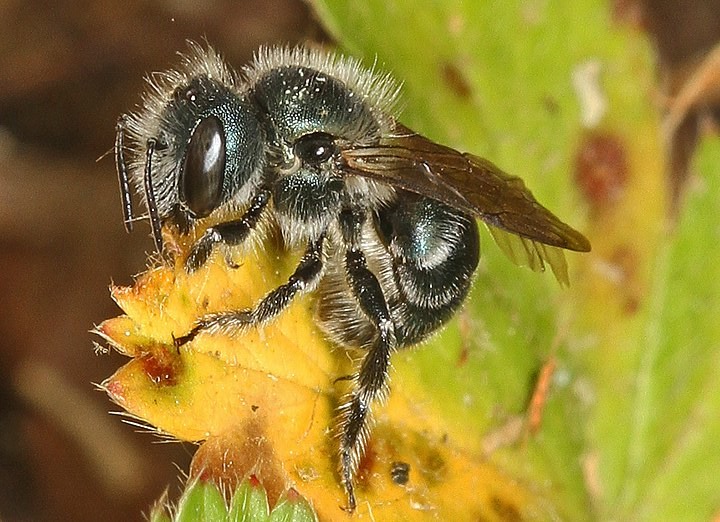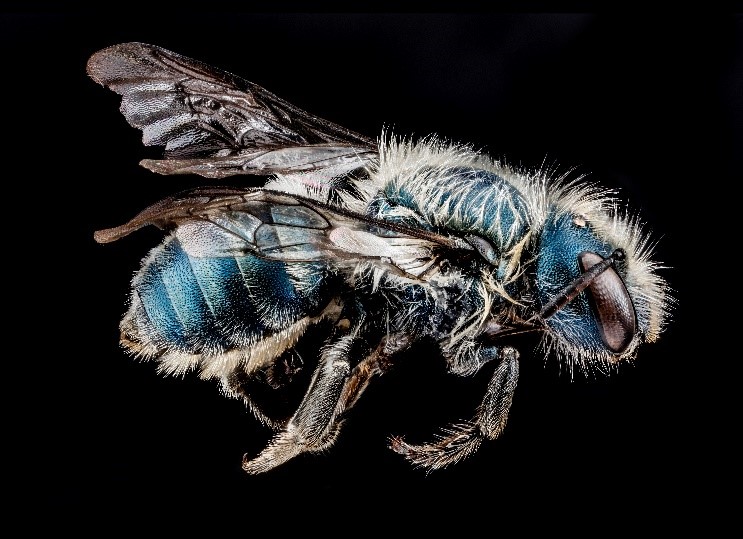In honor of National Pollinator Week last month, let’s give a tribute to a native New York bee. While there are hundreds of bee species in the state, this shout-out is for one species – the mason bee.

A mason bee (Osmia sp.) (Photo Credit – Wikimedia Commons)
“What are Mason Bees?”
While there are over 400 species of bees in New York State, mason bees comprise only about 7 percent of that diversity. These small bees are important pollinators of crops, wildflowers, and many other woodland, meadow and wetland plants. Unlike honeybees, which are sial in nature, mason bees are solitary. They construct individual nests in hollow reeds or other plant stems, pre-existing cavities, or burrows found in dead wood. Their name stems their practice of transporting mud to nesting areas to build structures in which they eventually lay eggs.
Mason bees come from the tribe Osmini of the family Megachilidae. In New York State, mason bees include genera such as Osmia, Hoplitis, Chelostoma, and Heriades. Each genera has specific characteristics. Also, these mild-mannered bees only sting if provoked or cornered, so they are ideal for observing up close.
Osmia Mason Bees: When referring to “mason bees”, many people would generally reference them to the bees of genera Osmia. A key trait of these types of bees that they are an energetic fast flier. Osmia mason bees tend to be small-to-medium in size with a robust build and relatively large heads. Within the genera, there are three subgenera (or subspecies): Helicosmia, Melanosmia, and Osmia. In New York, there are at least 25 native Osmia species.

Hoplitis Mason Bees: They are the pollinators of woodland shrubs and trees, garden flowers and berries, while also visiting some varieties of commercial fruit. What makes them different from Osmia mason bees is that their bodies are slenderer. Hoplitis mason bees tend to be black to darkly-colored with pale abdominal stripes. These bees use chewed leaves, dirt, pebbles, or wood particles to construct walls between the brood cells of their nests. There are seven Hoplitis species found in New York.

Chelostoma Mason Bees: They are the only type of mason bee native to New York State that is represented solely by one species, the mock orange Chelostoma, Chelostoma philadelphi

Their appearance is small and ant-like, with disproportionately long jaws compared to the rest of its body. Bees that fall within this genus tend to be picky about which plants that they feed on and pollinate. Thus, the mock orange Chelostoma is a pollinator of the mock orange shrub (genus Philadelphus after which the bee was named). However, for those who are bee enthusiasts, there are also two non-native species of Chelostoma in New York that tend to feed on bellflowers.
Heriades Bees: Last, but certainly not least, is the resin bee, genus Heriades. What are resin bees? Resin bees and mason bees are quite similar to one another in terms of their lifestyles; they are both solitary bees; living in nests rather than hives. But unlike the other three genera, resin bee nests are located in the ground. Heriades bees can forage on a range of plants, not prioritizing one over the other when pollinating crops and wild plants. These bees tend to be dark in color with a slender-to-medium build, having sparse body hair that cover their bodies.

“What is the life cycle of a mason bee?”
While their lives are short, mason bee are very hard workers, making then truly a “busy bee.”
There is only one generation of mason bee per year.
Inside each nest tunnel or cavity, there are about 5 or 6 cocoons each containing a full-grown bee awaiting the right time to emerge. Each cocoon within the tunnel is separated by a thin mud wall placed there by the adult mother bee the spring before. The end of each tunnel is capped with a thick plug of mud or chewed leaves to keep the young safe through the winter.
In spring, after the temperate hits a consistent high of 55 degrees, both male and females emerge from their cocoons. Male bees always emerge first, remaining close to the nest, leaving their mark while waiting for the female mason bees. They leave only to feed on the nectar from flowers and plants.
Females hatch unable to fly, and immediately mate with the waiting male mason bees. Females mate with several males during this period. After mating, the males die and complete their life cycle. Unlike their females in their species, male mason bees only live for a few days.

A Female’s World
Female mason bees begin to nest about 3 to 4 days after mating, usually preferring to nest in preexisting holes. The bees plug the bottom of the hole with mud, then begin to bring both pollen and nectar from nearby plant blossoms to place in the hole as well.
After accumulating enough food for her young, the female lays eggs on top of the pollen and seals the cell with thin mud. She repeats this process until either the entire length of the tunnel is used or until she lays all of her eggs. The sperm that was stored from mating with the male mason bee acts as a fertilizer for the eggs, but only if she wants to have female offspring. An unfertilized egg will become male. Typically, two-thirds of cocoons will be male mason bees.
Hatching in a few days, larvae devour the pollen and nectar mixture in the nest. The amount of mixture that the female gathered determines the size of the emerging bees of the following spring. The larger the piles of pollen and nectar, the larger the bees.
In about ten days, the larvae spin into a cocoon and pupate inside. Towards the end of summer, the bees turn in to an imago, their adult stage and remains in their cocoon until next spring. Their roles completed, the female mason bees die that fall and the cycle begins all over again.
“How do you make a mason bee house?”
Well I am glad you asked. This is a really fun way to attract mason bees to your yard.
An example of a solitary bee house was constructed by Sarah Witalka, a conservation steward for the Thousand Islands Region at Westcott Beach State Park, while working at its pollinator garden. If you are not that big into woodworking, you are not out of luck. Stewards at Westcott Beach made one with an old Gatorade bottle and hollow plant stems.

Here’s how!
- Gather hollow stems from large flower stalks like goldenrod, daisies, black-eyed-susan, or Phragmites (also known as reed).
- If you do not know, Phragmites are an invasive reed that can be easily found by water and ditches. Keep the stems but leave the flowering head or seeds at the site or discard bag so you do not spread this invasive weed around!
- Score the stalks with a knife (always have an adult present to do this part), then snap the lengths.
- If using reed or grass, cut so that each tube ends in a node and is solid. Otherwise plug one end of each tube with mud.
- If that part is not done and the end of the tube was left open, a bee would not use it.
- Put as many tubes in the bottle as will fit, open end facing out towards you.
- Then use twigs to fill the spaces, so everything remains snug.
- If the original tubes were a little long for the bottle, a lip could be added in order to keep the rain off.
- Lastly, attach twine to hang it with.
Tips for placement:
- The front of the house should have a south or southwest exposure where it will get the most sun in winter to keep bees warm. REMEMBER! Bees are cold-blooded and they need the warmth of the sun to get going!
- Choose a secure and peaceful place, not one that sways or is noisy and full of movement; areas protected from high winds.
- Hang at eye level to keep them safe from critters and easy to check.
- Avoid installing the bee house right next to a bird feeder or birdhouse.
- Placed within about 300ft./100m of your garden, fruit & nut trees or berry patches to get the most benefit of these pollinators
- Plant or encourage NY native plants in your yard to benefit the native bees.

Mason bees are among the hundreds of pollinators in North America that you can learn about. Learn to appreciate the job that these insects are committed to do every single year.
If you would like to read more about mason bees, follow these links to obtain a broader knowledge on not just mason bees, but all kinds of native bees.
Cover photo- Female Mason bee on a flower (Photo credit- Joseph Berger, Bugwood.org, under Creative Commons Attribution 3.0 License)
Post by Kelley Anne Thomas, Office of Parks, Recreation and Historic Preservation Environmental Steward and Student Conservation Association member;and Julie Lundgren, State Parks Ecologist, NY Natural Heritage Program
Websites and Links
Bee Diversity in New York Cornell University College of Agriculture and Life Sciences
Sharp-Eatman Nature Photography
Empire State Native Pollinator Survey
The Honeybee Conservancy- Mason Bees


One thought on “The Wonderful World of Mason Bees”